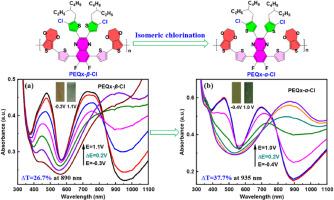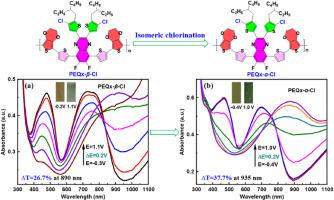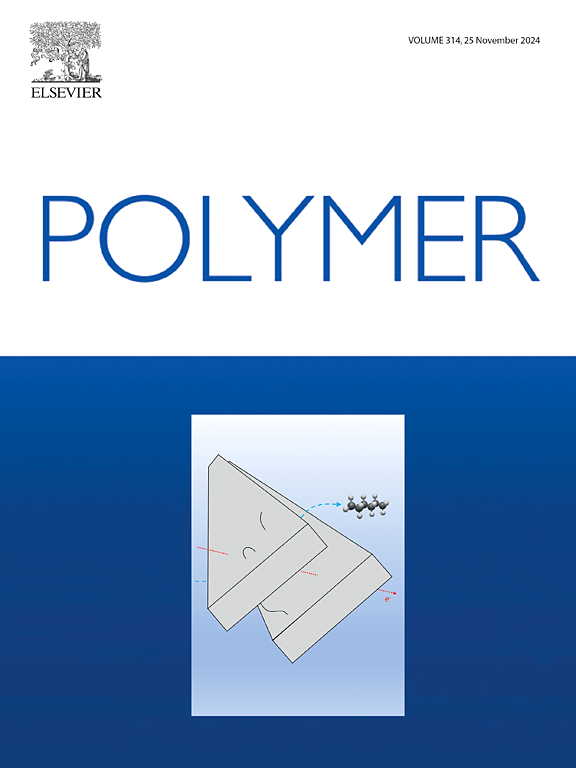基于喹喔啉的共轭噻吩侧链异构氯化法设计高性能电致变色聚合物
IF 4.1
2区 化学
Q2 POLYMER SCIENCE
引用次数: 0
摘要
共轭侧链的异构氯化是改善聚合物光电子特性的有效方法,但在电致变色性能方面还没有得到很好的研究。在此,两种新的 D-A-D 型异构单体 EQx-α-Cl 和 EQx-β-Cl,分别基于 2,3-双(5-氯-4-(2-乙基己基)噻吩-2-基)-6,7-二氟-5,8-二(噻吩-2-基)喹喔啉(Qx-α-Cl)和 2,3-双(4-氯-5-(2-乙基己基)噻吩-2-基)-6,7-二氟-5,8-二(噻吩-2-基)喹喔啉(Qx-α-Cl)、通过对共轭噻吩侧链的不同位置进行异构氯化,设计并合成了以 2,3-双(4-氯-5-(2-乙基己基)噻吩-2-基)-6,7-二氟-5,8-二(噻吩-2-基)喹喔啉(Qx-β-Cl)为受体单元的聚合物。然后通过电化学聚合反应合成了它们的 D-A-D 型聚合物(PEQx-α-Cl 和 PEQx-β-Cl)。与 EQx-β-Cl 的摩尔消光系数(7.26×104 M-1 cm-1 和 0.73 V)相比,EQx-α-Cl 不仅具有轻微的红移吸收起始点和更强的吸收(摩尔消光系数为 1.16×105 M-1 cm-1),而且具有更低的起始氧化电位(Eonset)(0.65 V)。与 PEQx-β-Cl 相比,PEQx-α-Cl 在中性态呈黄绿色,在氧化态呈深绿色,具有更好的电化学稳定性和电致变色性能,包括更高的光学对比度(37.7%)和 890 纳米波长下的 CE 值(319 cm2 C-1),有利于设计电致变色材料,实现自适应伪装应用。这些结果表明,共轭侧链的异构氯化策略是一种很有前景的方法,可为设计和合成高性能电致变色聚合物开辟新天地。本文章由计算机程序翻译,如有差异,请以英文原文为准。


Isomeric chlorination of conjugated thiophene side chain based on quinoxaline to design high-performance electrochromic polymers
The isomeric chlorination of the conjugated side chain is an effective method to improve the photoelectronic properties of polymers, but has not been well investigated in electrochromic performance. Herein, two new D-A-D type isomeric monomers, EQx-α-Cl and EQx-β-Cl, based on 2,3-bis(5-chloro-4-(2-ethylhexyl)thioph-en-2-yl)-6,7-difluoro-5,8-di(thiophen-2-yl)quinoxaline (Qx-α-Cl) and 2,3-bis(4-chloro-5-(2-ethylhexyl)thiophen-2-yl)-6,7-difluoro-5,8-di(thiophen-2-yl)quinoxaline (Qx-β-Cl) as the acceptor units by the isomeric chlorination of the different position of the conjugated thiophene side chain were designed and synthesized. Then their D-A-D type polymers (PEQx-α-Cl and PEQx-β-Cl) were synthesized by electrochemical polymerization. EQx-α-Cl not only exhibits slight red-shifted absorption onset and much stronger absorption with molar extinction coefficient of 1.16 × 105 M−1 cm−1 but also shows lower onset oxidation potential (Eonset) of 0.65 V compared with those of EQx-β-Cl (7.26 × 104 M−1 cm−1 and 0.73 V). And PEQx-α-Cl displayed yellow green at neutral state and dark green at oxidation state, respectively, and showed much better electrochemical stability and electrochromic performance including the higher optical contrast 37.7 % and the CE value of 319 cm2 C−1 at 890 nm in comparison with PEQx-β-Cl, which was beneficial to design the electrochromic materials toward adaptive camouflage application. These results demonstrated that the isomeric chlorination strategy of conjugated side chain is a promising approach which may open up a new horizon for designing and synthesizing the high-performance electrochromic polymers.
求助全文
通过发布文献求助,成功后即可免费获取论文全文。
去求助
来源期刊

Polymer
化学-高分子科学
CiteScore
7.90
自引率
8.70%
发文量
959
审稿时长
32 days
期刊介绍:
Polymer is an interdisciplinary journal dedicated to publishing innovative and significant advances in Polymer Physics, Chemistry and Technology. We welcome submissions on polymer hybrids, nanocomposites, characterisation and self-assembly. Polymer also publishes work on the technological application of polymers in energy and optoelectronics.
The main scope is covered but not limited to the following core areas:
Polymer Materials
Nanocomposites and hybrid nanomaterials
Polymer blends, films, fibres, networks and porous materials
Physical Characterization
Characterisation, modelling and simulation* of molecular and materials properties in bulk, solution, and thin films
Polymer Engineering
Advanced multiscale processing methods
Polymer Synthesis, Modification and Self-assembly
Including designer polymer architectures, mechanisms and kinetics, and supramolecular polymerization
Technological Applications
Polymers for energy generation and storage
Polymer membranes for separation technology
Polymers for opto- and microelectronics.
 求助内容:
求助内容: 应助结果提醒方式:
应助结果提醒方式:


